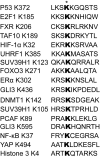Oncogene or Tumor Suppressor: The Coordinative Role of Lysine Methyltransferase SET7/9 in Cancer Development and the Related Mechanisms
- PMID: 35069908
- PMCID: PMC8771520
- DOI: 10.7150/jca.57663
Oncogene or Tumor Suppressor: The Coordinative Role of Lysine Methyltransferase SET7/9 in Cancer Development and the Related Mechanisms
Abstract
SET7/9 is a member of the protein lysine methyltransferase family that methylates both histone 3 lysine 4 (H3-K4) and lysine(s) of other non-histone proteins. In recent years, dis-regulation of SET7/9 were frequently detected in various cancer types and SET7/9-mediated methylation has been recognized as an important mechanism that affects cancer initiation and development through regulation of a series of cellular processes. Here we review the currently identified histone and non-histone protein targets of SET7/9 that are closely correlated with human cancer and the function of SET7/9 in regulating the expression and stability of its protein targets. The review also discusses the putative role of SET7/9 as an oncogene or tumor suppressor in the development of various cancer types and the underlying mechanisms, which may help better evaluate the potential of SET7/9 as a novel candidate for cancer therapy.
Keywords: SET7/9; cancer developments; lysine methyltransferase; methylation.
© The author(s).
Conflict of interest statement
Competing Interests: The authors have declared that no competing interest exists.
Figures








Similar articles
-
Non-histone Methylation of SET7/9 and its Biological Functions.Recent Pat Anticancer Drug Discov. 2022;17(3):231-243. doi: 10.2174/1574892816666211202160041. Recent Pat Anticancer Drug Discov. 2022. PMID: 34856916 Review.
-
Identification of Rpl29 as a major substrate of the lysine methyltransferase Set7/9.J Biol Chem. 2018 Aug 17;293(33):12770-12780. doi: 10.1074/jbc.RA118.002890. Epub 2018 Jun 29. J Biol Chem. 2018. PMID: 29959229 Free PMC article.
-
SET7/9 interacts and methylates the ribosomal protein, eL42 and regulates protein synthesis.Biochim Biophys Acta Mol Cell Res. 2020 Feb;1867(2):118611. doi: 10.1016/j.bbamcr.2019.118611. Epub 2019 Nov 19. Biochim Biophys Acta Mol Cell Res. 2020. PMID: 31751593
-
Purification and functional characterization of a histone H3-lysine 4-specific methyltransferase.Mol Cell. 2001 Dec;8(6):1207-17. doi: 10.1016/s1097-2765(01)00405-1. Mol Cell. 2001. PMID: 11779497
-
Transcriptional regulation by the Set7 lysine methyltransferase.Epigenetics. 2013 Apr;8(4):361-72. doi: 10.4161/epi.24234. Epub 2013 Mar 11. Epigenetics. 2013. PMID: 23478572 Free PMC article. Review.
Cited by
-
Methylation of the epigenetic JMJD2D protein by SET7/9 promotes prostate tumorigenesis.Front Oncol. 2023 Nov 17;13:1295613. doi: 10.3389/fonc.2023.1295613. eCollection 2023. Front Oncol. 2023. PMID: 38045004 Free PMC article.
-
Methyltransferase Set7/9 as a Multifaceted Regulator of ROS Response.Int J Biol Sci. 2023 Apr 23;19(8):2304-2318. doi: 10.7150/ijbs.83158. eCollection 2023. Int J Biol Sci. 2023. PMID: 37215983 Free PMC article. Review.
-
SET7/9-mediated methylation affects oncogenic functions of histone demethylase JMJD2A.JCI Insight. 2023 Oct 23;8(20):e164990. doi: 10.1172/jci.insight.164990. JCI Insight. 2023. PMID: 37870957 Free PMC article.
-
Post-Translational Modifications of BRD4: Therapeutic Targets for Tumor.Front Oncol. 2022 Mar 21;12:847701. doi: 10.3389/fonc.2022.847701. eCollection 2022. Front Oncol. 2022. PMID: 35402244 Free PMC article. Review.
-
H3 histone methylation landscape in male urogenital cancers: from molecular mechanisms to epigenetic biomarkers and therapeutic targets.Front Cell Dev Biol. 2023 May 9;11:1181764. doi: 10.3389/fcell.2023.1181764. eCollection 2023. Front Cell Dev Biol. 2023. PMID: 37228649 Free PMC article. Review.
References
-
- Marmorstein R. Structure of SET domain proteins: a new twist on histone methylation. Trends Biochem Sci. 2003;28(2):59–62. - PubMed
-
- Trievel RC, Beach BM, Dirk LM. et al. Structure and catalytic mechanism of a SET domain protein methyltransferase. Cell. 2002;111:91–103. - PubMed
-
- Wilson J, Jing C, Walker P. et al. Crystal structure and functional analysis of the histone methyltransferase SET7/9. Cell. 2002;111:105–115. - PubMed
-
- Manzur KL, Farooq A, Zeng L. et al. A dimeric viral SET domain methyltransferase specific to Lys27 of histone H3. Nat Struct Biol. 2003;10:187–196. - PubMed
Publication types
LinkOut - more resources
Full Text Sources

